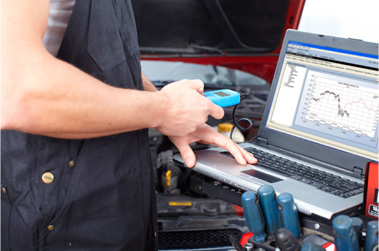
We have a full range of diagnostic test equipment. To help get to the root of the problem even a check engine light. The intended of the light is to alert the driver when there is a failure in the system. In most cases if the system is not promptly repaired, damage to other components can occur.
The OBD II systems require more control of vehicle emissions and more precise monitoring of emission-related devices.
OBD II diagnostic system continuously monitors all engine and transmission sensors and actuators for shorts, opens, and out-of-range values, as well as values that do not logically fit with other powertrain data (rationality). On the first trip during which the comprehensive component monitor detects a failure that results in emissions exceeding a predetermined level, the PCM stores a diagnostic trouble code (DTC), illuminates the malfunction indicator lamp (MIL), and stores a freeze frame.
The OBD II diagnostic system also actively tests some systems for proper operation while the vehicle is being driven. Fuel control and engine misfire are monitored continuously, while catalyst efficiency, EGR operation, EVAP integrity, O2S response, and the oxygen sensor heaters are tested once per trip. When any of the system monitors detects a failure that causes emissions to exceed a predetermined level on two consecutive trips, the PCM stores a freeze frame.
The monitor readiness status indicates whether or not a particular OBD II diagnostic monitor has been run since the last time that DTCs were cleared from PCM memory. If the monitor has not yet run, the status displays on the scan tool as “NO.” If the monitor has been run, the status displays on the scan tool as “YES.” This does not mean no faults were found, only that the diagnostic monitor has been run. Whenever DTCs are cleared from memory or the battery is disconnected, all monitor readiness status indicators are reset to “NO.” Monitor readiness status indicators are not needed for the comprehensive component, fuel control, and engine misfire monitors because they run continuously.
Most OBD II diagnostic monitors run at some time during normal operation of the vehicle. However, to satisfy all of the different trip enable criteria and run all of the OBD II diagnostic monitors, the vehicle must be driven under a variety of very specific conditions.

